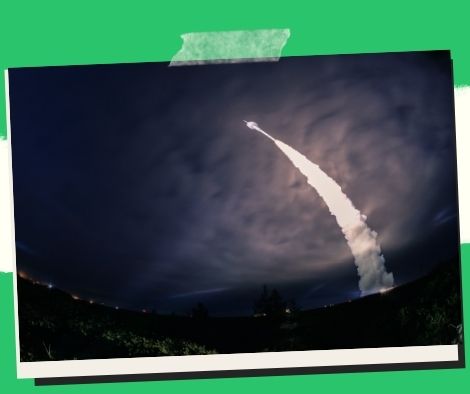
Two short-range ballistic missiles are fired by North Korea toward the East Sea.
The South Korean military reported that on Monday, North Korea launched two SRBMs toward the East Sea.
The action was taken a day after joint air exercises between South Korea and the US using B-1B bombers were held in response to the North’s launch of a long-range missile.
The launch was detected by the Joint Chiefs of Staff (JCS) between 7 and 7:11 in the morning from the Sukchon area in South Pyongan Province, and the missiles traveled about 390 and 340 kilometers, respectively.
The Korean People’s Army’s artillery unit launched two projectiles from a 600-mm multiple rocket launcher during firing drills, the North’s official Korean Central News Agency (KCNA) announced hours after the launch, and they traveled 395 km and 337 km, respectively.
According to a report in English published by the KCNA, the weapon system is a “tactical nuclear assault means boasting of the tremendous strength powerful enough to assign only one multiple rocket launcher with four shells so as to demolish an enemy functioning airfield.”
Kim Jong-un, the country’s leader, referred to the 600-mm rocket launcher as an “offensive weapon” that could carry tactical nuclear weapons and bring the entirety of South Korea within its range at a ceremony to “present” it at a significant party meeting in late December.
Given their flying distance, some local observers noticed that the missiles fired on Monday can reach an air facility in Cheongju, South Korea, which is known to be home to the South’s F-35A stealth fighters. 112 kilometers to the south of Seoul is Cheongju.
The allies’ claimed intention to expand the “frequency and intensity of deploying U.S. strategic assets” to Korea was disputed by the KCNA.
The latest missile launches by the North were “seriously” denounced by the military of the South as an act of “major provocation” that threatened both regional and global peace and stability.
The provocation was also referred to as a “clear” breach of resolutions passed by the U.N. Security Council, and the North was urged to immediately discontinue such provocative actions.
The JCS said in a text message sent to reporters that “our military will ensure a firm response posture based on security cooperation among the South, the United States, and Japan, and maintain a firm readiness posture based on capabilities to respond overwhelmingly to any North Korean provocations.”
In a press release on a North Korean missile launch, the South Korean military rarely mentions security cooperation with Japan. This is a hint that Seoul is stepping up bilateral defense relations in response to the North’s increasing threats.
The United States repeated its “ironclad” security pledges to Japan and the South.
The missile tests, which the command described as highlighting the “destabilizing consequences of the DPRK’s illegal (weapons of mass destruction) and ballistic missile programs,” were made public by the command.
While the North launched what it claimed to be a Hwasong-15 intercontinental ballistic missile (ICBM) the day before, the partners conducted air drills using U.S. bombers and South Korean F-35A stealth aircraft on Sunday.
The powerful Kim Yo-jong, sister of North Korean leader Kim Jong-un, has again threatened to take “corresponding” military action against allied drills.
In a statement that was translated into English and published by the KCNA, she said, “The frequency of using the Pacific as our firing range relies upon the U.S.
She also voiced disappointment that South Korean specialists had questioned the North’s capability to undertake a “surprise” ICBM launch, as well as other ICBM-related capabilities, including its atmospheric reentry technology.
She declared, “We have adequate technology and capability and will now concentrate on growing the size of their army. “Instead of doubting or being concerned about other people’s technologies, they had better rack their brains to come up with ways to defend themselves.”
She continued by saying that the North is “carefully” assessing how the deployment of American strategic assets will affect its security and that it will “take commensurate counteraction” if it determines that the move poses a “direct or indirect” threat to the North.
Both the springtime Freedom Shield exercise and a tabletop military drill against North Korean nuclear threats are set to take place this week.
Save/Share this story with QR CODE
Disclaimer
This article is for informational purposes only and does not constitute endorsement of any specific technologies or methodologies and financial advice or endorsement of any specific products or services.
 Need to get in touch?
Need to get in touch?

We appreciate your reading. 
1.) 

Your DONATION will be used to fund and maintain NEXTGENDAY.com
Subscribers in the Philippines can make donations to mobile number 0917 906 3081, thru GCash.
3.) 
4.) 
AFFILIATE PARTNERS

World Class Nutritional Supplements - Buy Highest Quality Products, Purest Most Healthy Ingredients, Direct to your Door! Up to 90% OFF.
Join LiveGood Today - A company created to satisfy the world's most demanding leaders and entrepreneurs, with the best compensation plan today.

 Business, Finance & Technology
Business, Finance & Technology

 Business Technology, Finance Technology & Information Technology
Business Technology, Finance Technology & Information Technology






